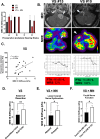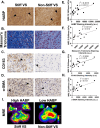Tumor biomechanical stiffness by magnetic resonance elastography predicts surgical outcomes and identifies biomarkers in vestibular schwannoma and meningioma
- PMID: 38914647
- PMCID: PMC11196577
- DOI: 10.1038/s41598-024-64597-1
Tumor biomechanical stiffness by magnetic resonance elastography predicts surgical outcomes and identifies biomarkers in vestibular schwannoma and meningioma
Abstract
Variations in the biomechanical stiffness of brain tumors can not only influence the difficulty of surgical resection but also impact postoperative outcomes. In a prospective, single-blinded study, we utilize pre-operative magnetic resonance elastography (MRE) to predict the stiffness of intracranial tumors intraoperatively and assess the impact of increased tumor stiffness on clinical outcomes following microsurgical resection of vestibular schwannomas (VS) and meningiomas. MRE measurements significantly correlated with intraoperative tumor stiffness and baseline hearing status of VS patients. Additionally, MRE stiffness was elevated in patients that underwent sub-total tumor resection compared to gross total resection and those with worse postoperative facial nerve function. Furthermore, we identify tumor microenvironment biomarkers of increased stiffness, including αSMA + myogenic fibroblasts, CD163 + macrophages, and HABP (hyaluronic acid binding protein). In a human VS cell line, a dose-dependent upregulation of HAS1-3, enzymes responsible for hyaluronan synthesis, was observed following stimulation with TNFα, a proinflammatory cytokine present in VS. Taken together, MRE is an accurate, non-invasive predictor of tumor stiffness in VS and meningiomas. VS with increased stiffness portends worse preoperative hearing and poorer postoperative outcomes. Moreover, inflammation-mediated hyaluronan deposition may lead to increased stiffness.
Keywords: MRI; Magnetic resonance elastography; Meningioma; Stiffness; Vestibular schwannoma.
© 2024. The Author(s).
Conflict of interest statement
The authors declare no competing interests.
Figures




References
-
- Macielak RJ, Harris MS, Mattingly JK, Shah VS, Prevedello LM, Adunka OF. Can an imaging marker of consistency predict intraoperative experience and clinical outcomes for vestibular schwannomas? A retrospective review. J. Neurol. Surg. B Skull Base. 2021;82(2):251–257. doi: 10.1055/s-0039-1697026. - DOI - PMC - PubMed
MeSH terms
Substances
Grants and funding
LinkOut - more resources
Full Text Sources
Medical
Research Materials

